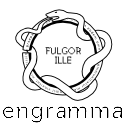Mnemosyne Atlas 31
Realismo antiretorico e devozione religiosa in Italia e al Nord
Lo stile antiretorico e spirituale di Piero della Francesca (cfr. tav. 30) trova eco nel gusto della committenza borghese fiorentina per il realismo nordico (ritratti dell’‘intellettuale-umanista’, pittura devozionale, miniature).
Anti-rhetorical realism and religious devotion in Italy and in the North
Piero della Francesca’s anti-rhetorical and spiritual style (see plate 30) reflects the taste of Florentine bourgeois patrons for Northern realism (portraits of intellectual humanists; devotional images; illuminations).
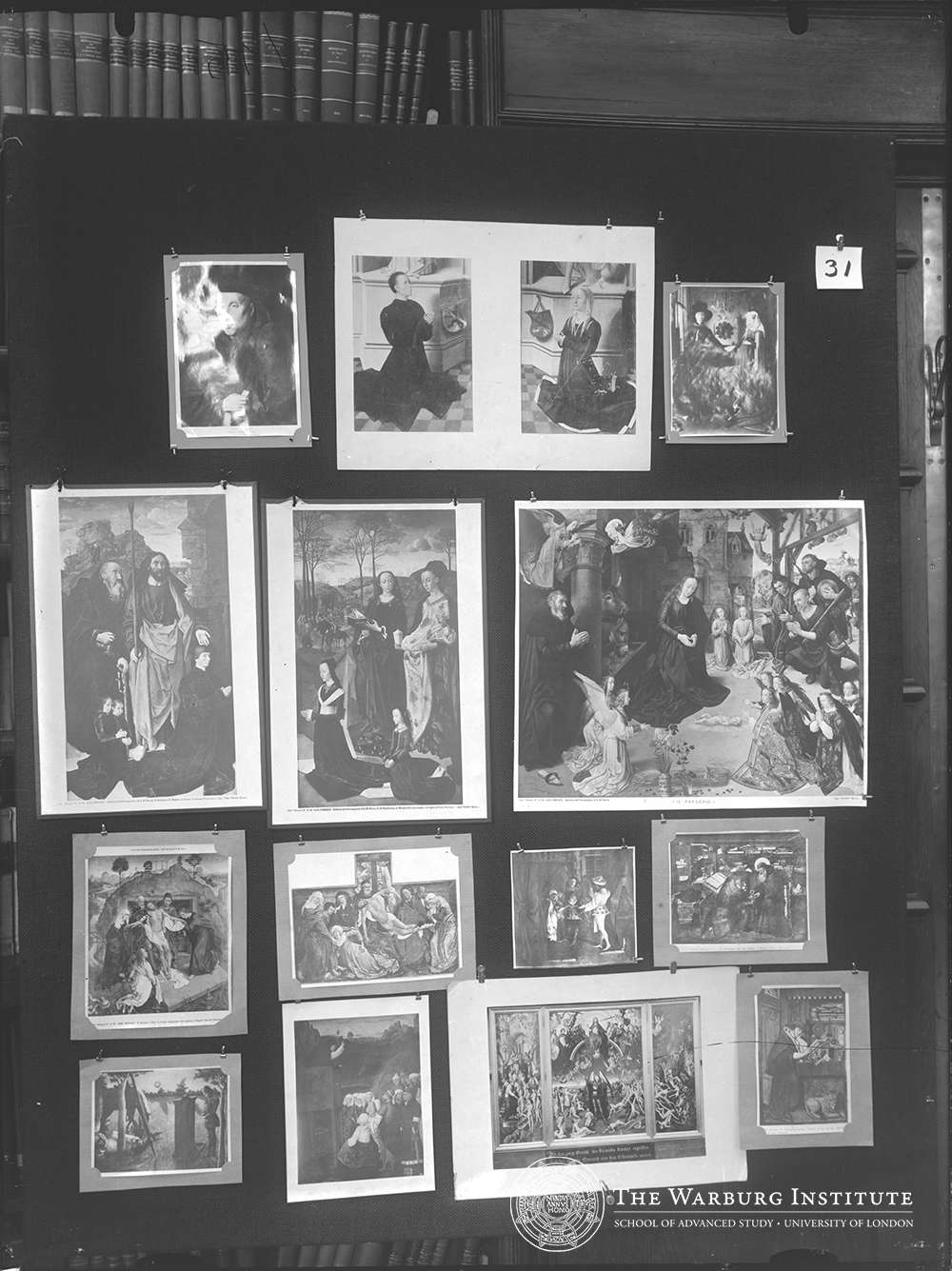
Appunti di Aby Warburg (1929)
Portinari
Portinari.
Appunti di Aby Warburg e collaboratori (1929)
Im Anschluß daran: der Norden. Andachtsbild. Flandrisierendes Porträt von Italienern. Grablegung. René als Besteller und S. Hss. Hieronymus im Gehäus.
In connessione a ciò: il Nord. Immagini devozionali. Ritratti fiamminghi di italiani. Deposizione. René come committente e c[ollezionista di] man[oscritti]. Girolamo nello studio.
Appunti di Gertrud Bing (1940 ca)
Das suchen d. Florentiner bei den fland. Malern? Nordischer Seelenspiegel. Einführung der flandrischen Komponente. 1) Portrait – Physiognomik als Gegensatz zur (mimischen) Gebärdensprache des Südens = innere Dramatik anstelle äußerer Bewegung. Ital. Familien, Tani, Portinari, Arnolfini, portraitiert von Flamen. 2) Darstellung verhaltenen Schmerzes bei relig. Themen. Innerliche Religiosität. Al. Macinghi = è una cosa devota. 3) Einkehr + Konzentration beim Denkeninnere. Betrachtung des Hieronymus. HS. des René: Versunkenheit (Landschaftsgefühl?) Lichtbehandlung. Dazu Simon Marninon in Neapel – angehl. Portrait des René. Auch hier nordisch Einfluss.
Cosa cercano i fiorentini nei pittori fiamminghi? Specchio dell’anima nordico. Introduzione della componente fiamminga. 1) Ritratto – Fisiognomica come contrapposizione al linguaggio gestuale (mimico) del Sud = dramma interiore anziché movimento esteriore. Le famiglie italiane, Tani, Portinari, Arnolfini, ritratte dai fiamminghi. 2) Rappresentazione del dolore trattenuto nei soggetti religiosi. Religiosità interiore. Alessandra Macinghi Strozzi = è una cosa devota. 3) Raccoglimento + Concentrazione: si pensa alla meditazione interiore di San Girolamo. Manoscritt del Maestro di René: contemplazione (sentimento del paesaggio?) Trattamento della luce. Inoltre Simon Marninon a Napoli – probabilmente ritratto del Maestro di René. Anche qui, influenza nordica.
Notes by Aby Warburg (1929)
Portinari
Portinari.
Notes by Aby Warburg and coll. (1929)
Im Anschluß daran: der Norden. Andachtsbild. Flandrisierendes Porträt von Italienern. Grablegung. René als Besteller und S. Hss. Hieronymus im Gehäus.
Following on from the previous panel: the North. Devotional image. Flemish-style portrait of italians. Entombment. René as commissioner and [collector of?] manuscripts. Jerome in his Study.
Notes by Gertrud Bing (ca. 1940)
Das suchen d. Florentiner bei den fland. Malern? Nordischer Seelenspiegel. Einführung der flandrischen Komponente. 1) Portrait – Physiognomik als Gegensatz zur (mimischen) Gebärdensprache des Südens = innere Dramatik anstelle äußerer Bewegung. Ital. Familien, Tani, Portinari, Arnolfini, portraitiert von Flamen. 2) Darstellung verhaltenen Schmerzes bei relig. Themen. Innerliche Religiosität. Al. Macinghi = è una cosa devota. 3) Einkehr + Konzentration beim Denkeninnere. Betrachtung des Hieronymus. HS. des René: Versunkenheit (Landschaftsgefühl?) Lichtbehandlung. Dazu Simon Marninon in Neapel – angehl. Portrait des René. Auch hier nordisch Einfluss.
What do Florentines look for in Flemish painters? Nordic mirror of the soul. Introduction of the Flemish component. 1) Portrait – Physiognomy as opposed to the gestural (mimic) language of the South = inner drama instead of outer movement. The Italian families, Tani, Portinari, Arnolfini, portrayed by the Flemish. 2) Representation of restrained pain in religious subjects. Inner religiosity. Alessandra Macinghi Strozzi = è una cosa devota. 3) Contemplation + Concentration: think of St Jerome’s inner meditation. Manuscript of the Master of René: contemplation (sentiment of landscape?) Treatment of light. In addition Simon Marninon in Naples – probably portrait of the Master of René. Again, Nordic influence.
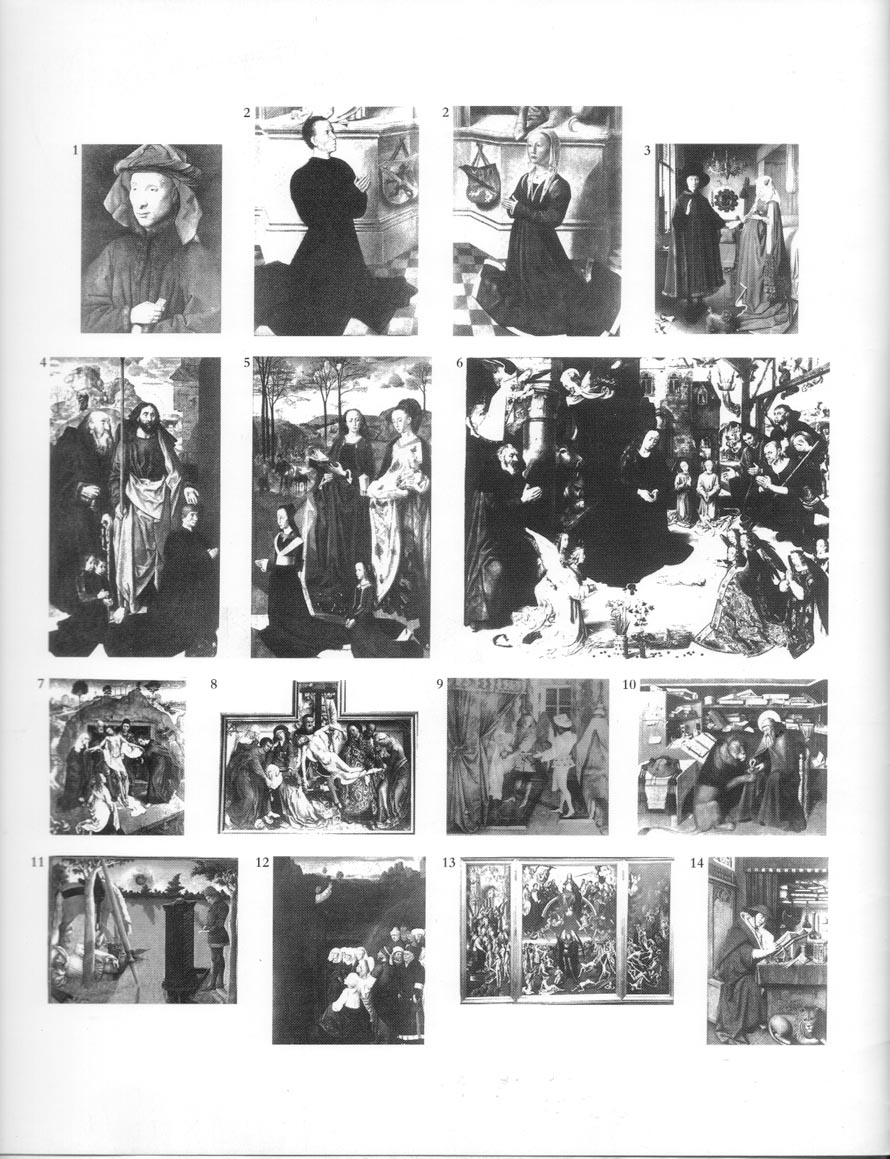
1. Jan van Eyck, Ritratto di Giovanni Arnolfini, olio su tavola, 1438 ca., Berlino, Staatliche Museen, Gemäldegalerie.
2. Hans Memling, Altare del giudizio universale, sportelli con i ritratti di Angelo Tani e Caterina Tanagli, olio su tavola, 1466-1473, Danzig, Muzeum Pomorskie, già Marienkirche.
3. Jan van Eyck, Ritratto dei coniugi Arnolfini, olio su tavola, 1434, Londra, National Gallery.
4. Hugo van der Goes, Ritratto di Tommaso Portinari con i figli e un santo, Altare Portinari (sportello sinistro), olio su tavola, 1476-1478, Firenze, Galleria degli Uffizi.
5. Hugo van der Goes, Ritratto di Maria Baroncelli con la figlia e una Santa, Altare Portinari (sportello destro), olio su tavola, 1476-1478, Firenze, Galleria degli Uffizi.
6. Hugo van der Goes, L'adorazione dei pastori, Altare Portinari(pala centrale), olio su tavola, 1476-1478, Firenze, Galleria degli Uffizi.
7. Rogier van der Weyden, Compianto e sepoltura di Cristo, olio su tavola, 1450 ca., Firenze, Galleria degli Uffizi.
8. Rogier van der Weyden, Deposizione dalla croce, parte mediana di un altare della chiesa di Notre-Dame-hors-les-Murs a Leuven, olio su tavola, 1430-1435, Madrid, Museo del Prado.
9. L'amore consegna al desiderio il cuore di Renato d'Angiò, miniatura da Barthélemy d'Eyck detto Maestro di René (attribuito), Le Livre du Coeur d'Amours Espris di Renato d'Angiò, manoscritto, 1457 ca., Vienna, Österreichische Nationalbibliothek, Cod. Vindob. 2597, fol. 2.
10. Colantonio, San Girolamo nello studio, olio su tavola, 1444-1445, Napoli, Museo di Capodimonte.
11. Il cavalier Coeur legge l'iscrizione sulla fontana della Fortuna, miniatura da Barthélemy d'Eyck detto Maestro di René (attribuito), Le Livre du Coeur d'Amours Espris di Renato d'Angiò, manoscritto, 1457 ca., Vienna, Österreichische Nationalbibliothek, Cod. Vindob. 2597, fol. 12v.
12. Colantonio, Scena dalla vita di S. Vincenzo Ferrer, pannello da un polittico, Napoli, San Pietro Martire, Napoli, Museo di Capodimonte.
13. Hans Memling, Trittico del giudizio universale, olio su tavola, 1466-1473, Danzig, Muzeum Pomorskie, già Marienkirche.
14. Jan van Eyck?, San Girolamo nello studio, tempera e olio su tavola, Detroit, Institute of Fine Arts.
1. Jan van Eyck, Portrait of Giovanni di Nicolao Arnolfini, oil on table, 1438 ca., Berlin, Staatliche Museen, Gemäldegalerie.
2 Hans Memling, The Last Judgment, counters with portraits of Angelo Tani and Caterina Tanagli, oil on table, 1466-1473, Danzig, Muzeum Pomorskie, formerly Marienkirche.
3. Jan van Eyck, Arnolfini Portrait, olio su tavola, 1434, London, National Gallery.
4. Hugo van der Goes, Portrait of Tommaso Portinari with his sons and a mail saint, Portinari Altar (left door), oil on table, 1476-1478, Firenze, Galleria degli Uffizi.
5. Hugo van der Goes, Portrait of Maria Baroncelli with her daughter and a female Saint, Portinari Altar (right door), oil on table, 1476-1478, Firenze, Galleria degli Uffizi.
6. Hugo van der Goes, Adoration of the shepherds, Portinari Altar (central altarpiece), oil on table, 1476-1478, Firenze, Galleria degli Uffizi.
7. Rogier van der Weyden, Lamentation of Christ, oil on table, 1450 ca., Firenze, Galleria degli Uffizi.
8. Rogier van der Weyden, The Descent from the Cross, central alterpiece of Notre-Dame-hors-les-Murs Church in Leuven, oil on table, 1430-1435, Madrid, Museo del Prado.
9. Love delivers Renato d’Anjou’s heart to desire, illumination from Barthélemy d’Eyck named Maestro di René (attributed), Le Livre du Coeur d'Amours Espris di Renato d'Angiò, manuscript, 1457 ca., Wien, Österreichische Nationalbibliothek, Cod. Vindob. 2597, fol. 2.
10. Colantonio, Saint Jerome in His Study, oil on table, 1444-1445, Napoli, Museo di Capodimonte.
11. Chevalier Coeur reads the inscription on the fountain of Fortune, illumination from Barthélemy d’Eyck named Maestro di René (attributed), Le Livre du Coeur d'Amours Espris di Renato d'Angiò, manuscript, 1457 ca., Wien, Österreichische Nationalbibliothek, Cod. Vindob. 2597, fol. 12v.
12. Colantonio, Scene from the life of St. Vincent Ferrer, panel from a polyptych, Napoli, San Pietro Martire, Napoli, Museo di Capodimonte.
13. Hans Memling, The Last Judgment, triptych, oil on table, 1466-1473, Danzig, Muzeum Pomorskie, formerly Marienkirche.
14. Jan van Eyck, Saint Jerome in His Study, tempera and oil on table, Detroit, Institute of Fine Arts.
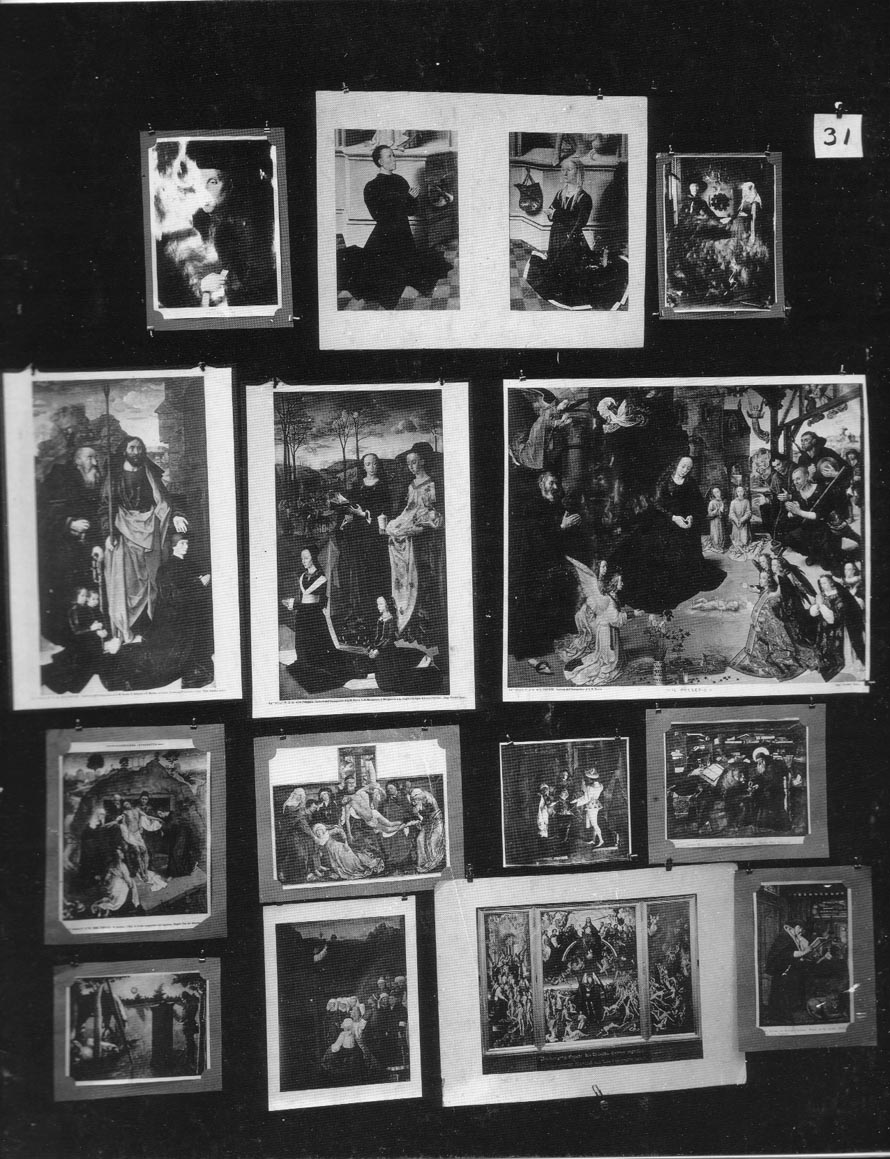
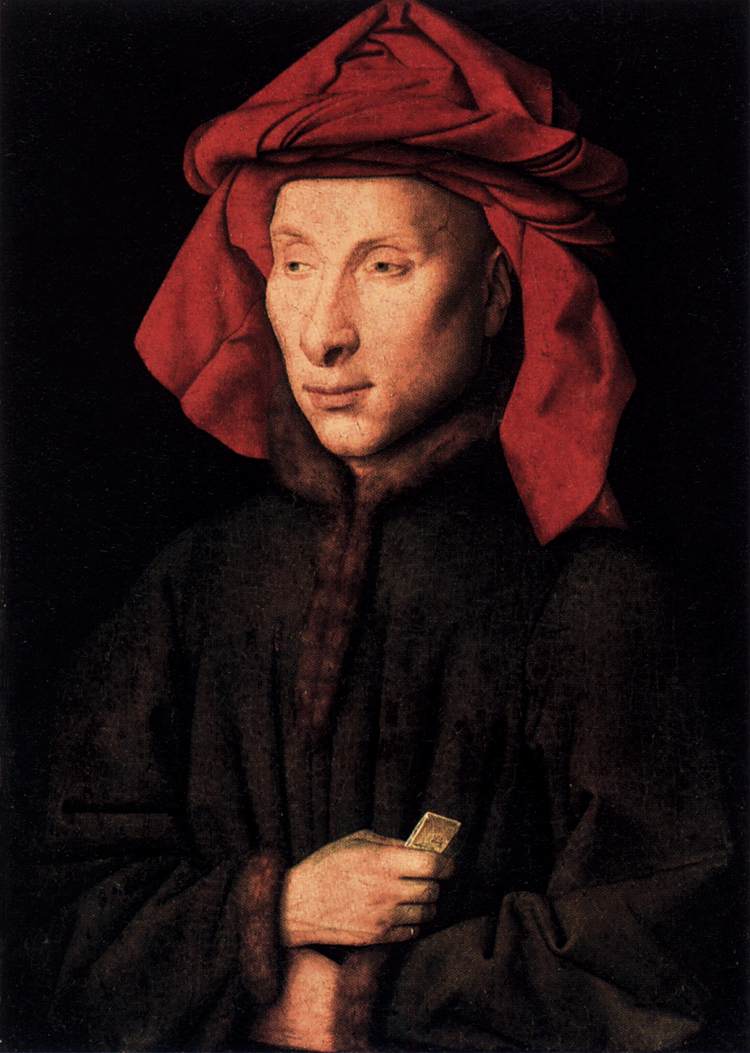
31_1 | Jan van Eyck, Ritratto di Giovanni Arnolfini, olio su tavola, 1438 ca., Berlino, Staatliche Museen, Gemäldegalerie.
31_1 | Jan van Eyck, Portrait of Giovanni di Nicolao Arnolfini, oil on table, 1438 ca., Berlin, Staatliche Museen, Gemäldegalerie

31_2 | Hans Memling, Altare del giudizio universale, sportello con il ritratto di Angelo Tani, olio su tavola, 1466-1473, Danzig, Muzeum Pomorskie, già Marienkirche.
31_2 | Hans Memling, The Last Judgment, counter with portrait of Angelo Tani, oil on table, 1466-1473, Danzig, Muzeum Pomorskie, formerly Marienkirche.

31_2b | Hans Memling, Altare del giudizio universale, sportelli con il ritratto di Caterina Tanagli (Caterina Tanagli), olio su tavola, 1466-1473, Danzig, Muzeum Pomorskie, già Marienkirche
31_2b | Hans Memling, The Last Judgment, counter with portrait of Caterina Tanagli, oil on table, 1466-1473, Danzig, Muzeum Pomorskie, formerly Marienkirche.
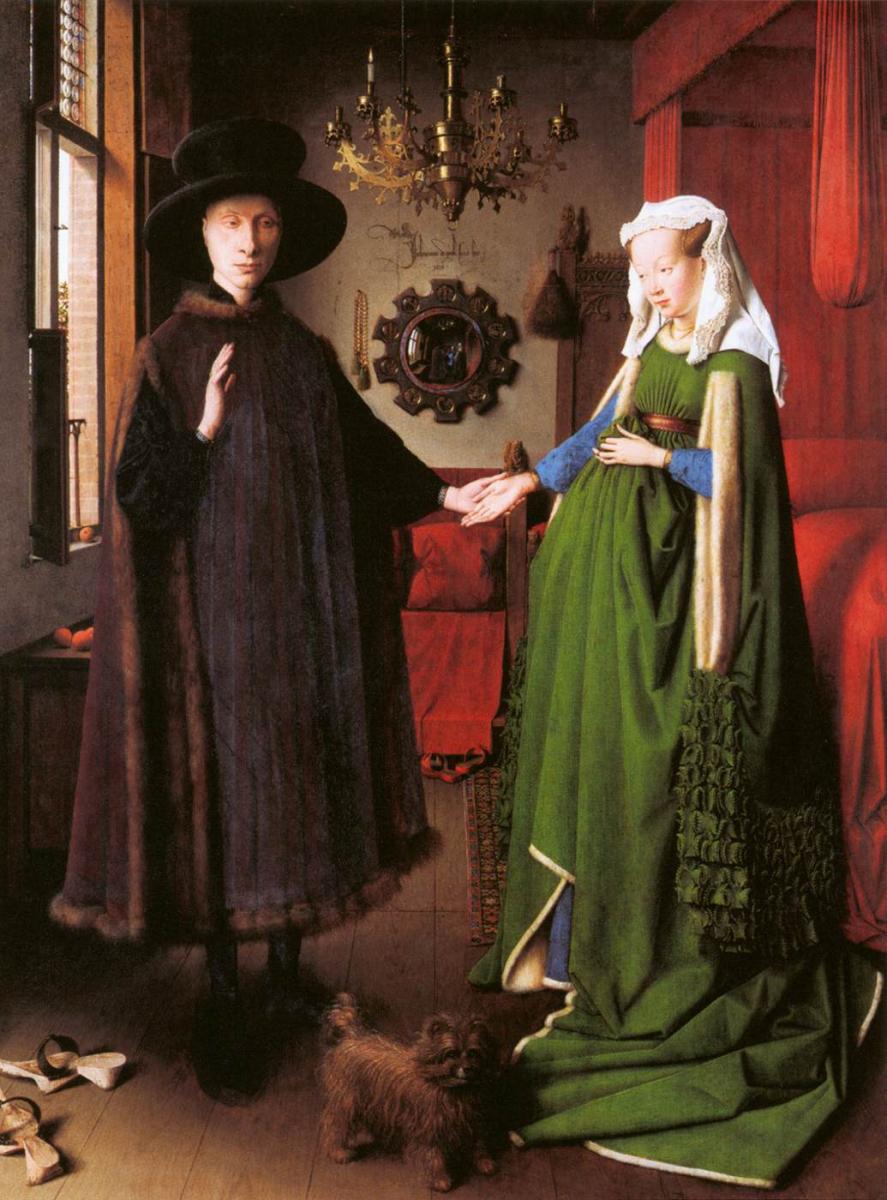
31_3 | Jan van Eyck, Ritratto dei coniugi Arnolfini, olio su tavola, 1434, Londra, National Gallery.
31_3 | Jan van Eyck, Arnolfini Portrait, olio su tavola, 1434, London, National Gallery.
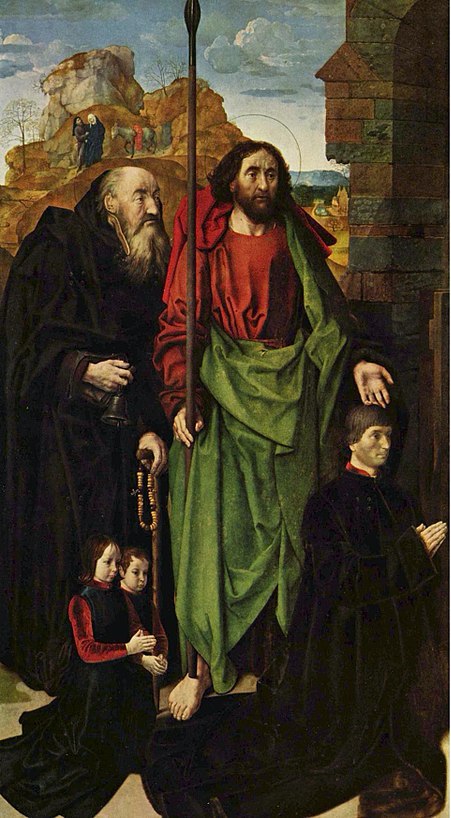
31_4 | Hugo van der Goes, Ritratto di Tommaso Portinari con i figli e un santo, Altare Portinari (sportello sinistro), olio su tavola, 1476-1478, Firenze, Galleria degli Uffizi.
31_4 | Hugo van der Goes, Portrait of Tommaso Portinari with his sons and a mail saint, Portinari Altar (left door), oil on table, 1476-1478, Firenze, Galleria degli Uffizi.
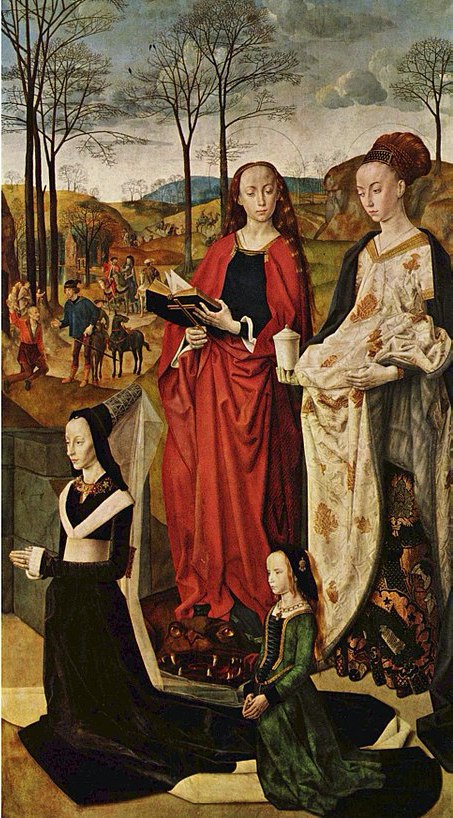
31_5 | Hugo van der Goes, Ritratto di Maria Baroncelli con la figlia e una Santa, Altare Portinari (sportello destro), olio su tavola, 1476-1478, Firenze, Galleria degli Uffizi.
31_5 | Hugo van der Goes, Portrait of Maria Baroncelli with her daughter and a female Saint, Portinari Altar (right door), oil on table, 1476-1478, Firenze, Galleria degli Uffizi.
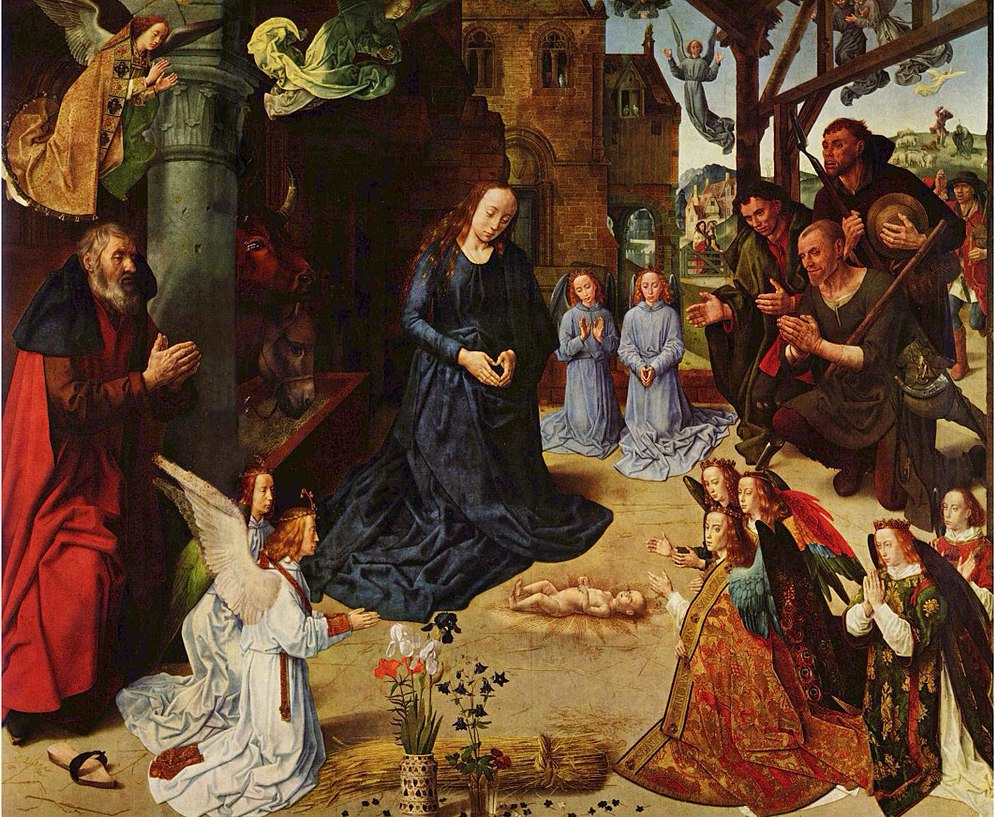
31_6 | Hugo van der Goes, L'adorazione dei pastori, Altare Portinari(pala centrale), olio su tavola, 1476-1478, Firenze, Galleria degli Uffizi.
31_6 | Hugo van der Goes, Adoration of the shepherds, Portinari Altar (central altarpiece), oil on table, 1476-1478, Firenze, Galleria degli Uffizi.
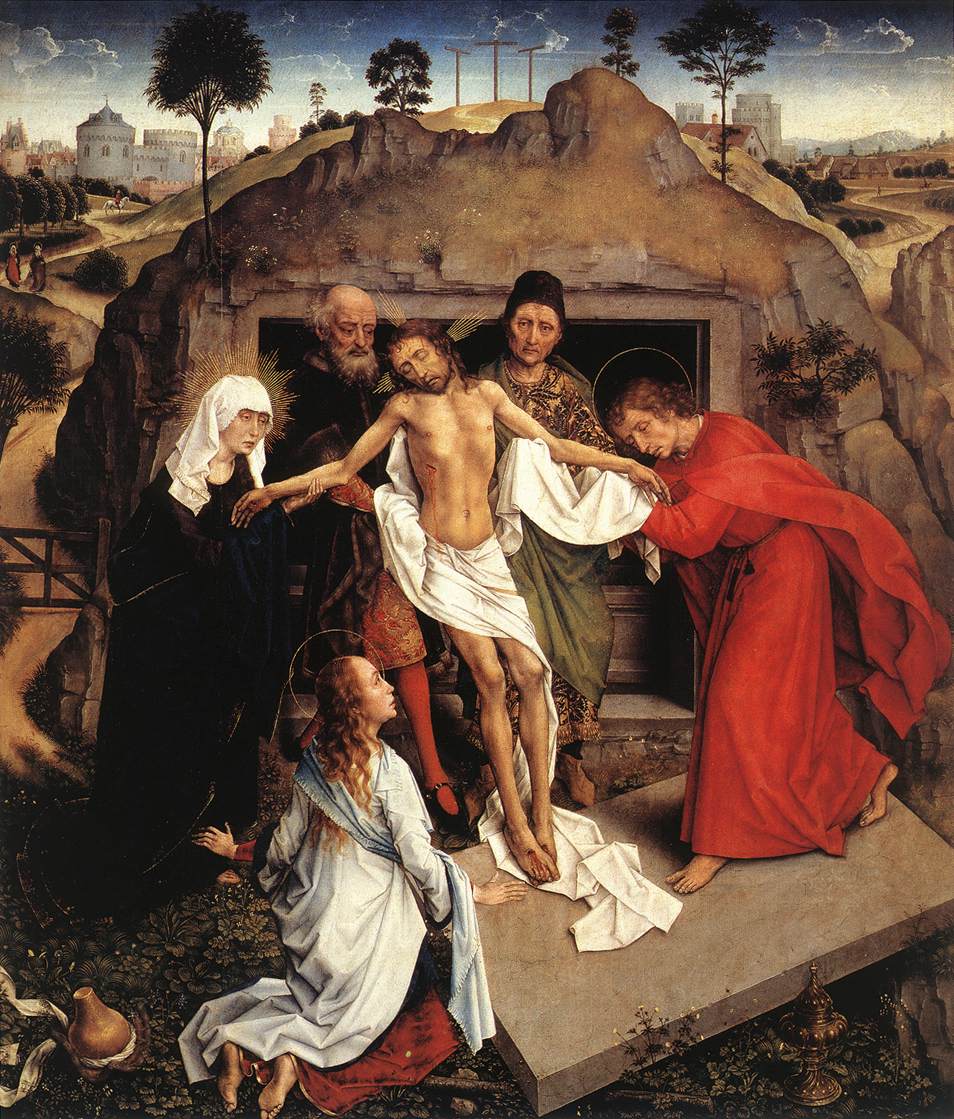
31_7 | Rogier van der Weyden, Compianto e sepoltura di Cristo, olio su tavola, 1450 ca., Firenze, Galleria degli Uffizi.
31_7 | Rogier van der Weyden, Lamentation of Christ, oil on table, 1450 ca., Firenze, Galleria degli Uffizi.
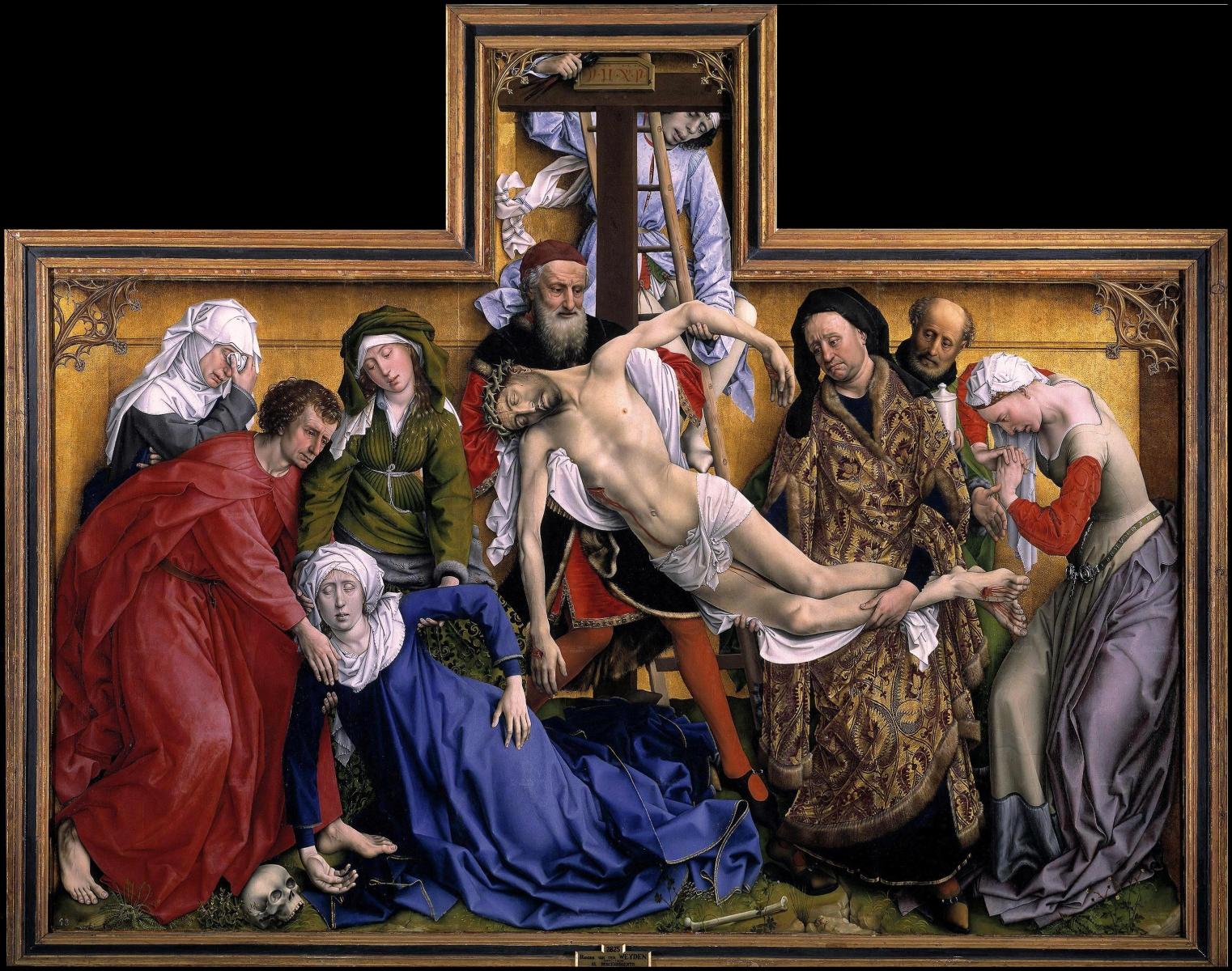
31_8 | Rogier van der Weyden, Deposizione dalla croce, parte mediana di un altare della chiesa di Notre-Dame-hors-les-Murs a Leuven, olio su tavola, 1430-1435, Madrid, Museo del Prado.
31_8 | Rogier van der Weyden, The Descent from the Cross, central alterpiece of Notre-Dame-hors-les-Murs Church in Leuven, oil on table, 1430-1435, Madrid, Museo del Prado.
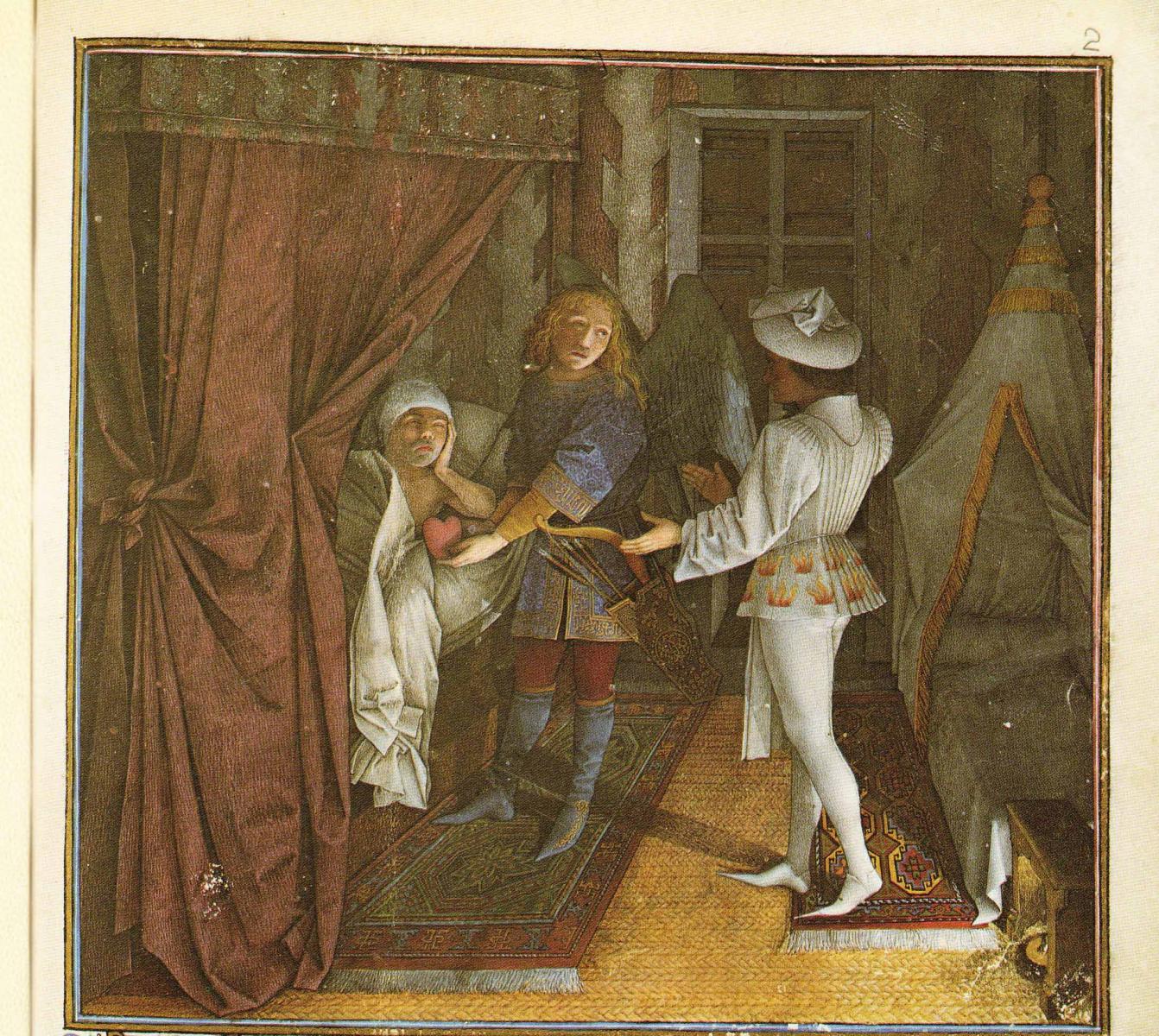
31_9 | L'amore consegna al desiderio il cuore di Renato d'Angiò, miniatura da Barthélemy d'Eyck detto Maestro di René (attribuito), Le Livre du Coeur d'Amours Espris di Renato d'Angiò, manoscritto, 1457 ca., Vienna, Österreichische Nationalbibliothek, Cod. Vindob. 2597, fol. 2.
31_9 | Love delivers Renato d’Anjou’s heart to desire, illumination from Barthélemy d’Eyck named Maestro di René (attributed), Le Livre du Coeur d'Amours Espris di Renato d'Angiò, manuscript, 1457 ca., Wien, Österreichische Nationalbibliothek, Cod. Vindob. 2597, fol. 2.
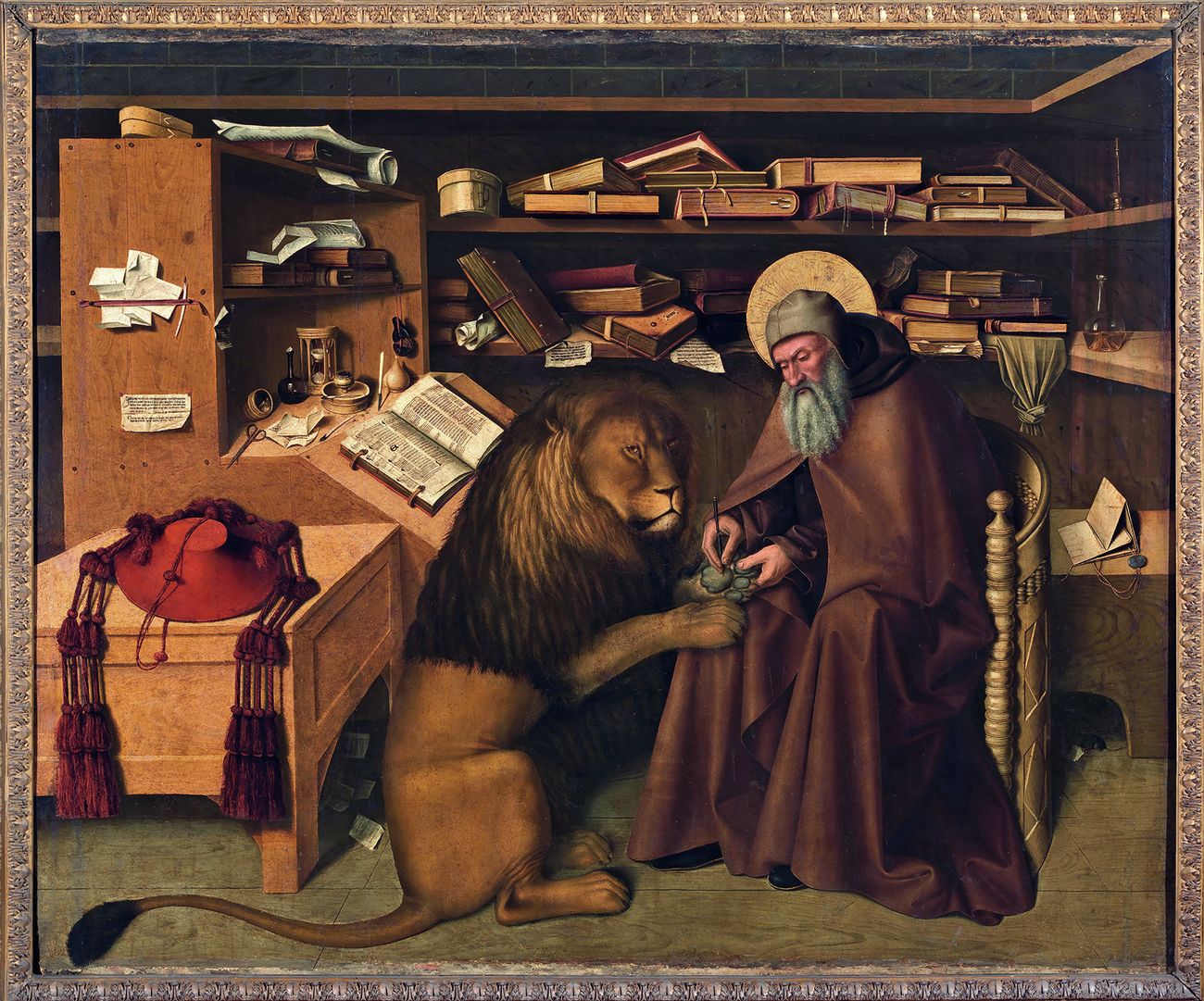
31_10 | Colantonio, San Girolamo nello studio, olio su tavola, 1444-1445, Napoli, Museo di Capodimonte.
31_10 | Colantonio, Saint Jerome in His Study, oil on table, 1444-1445, Napoli, Museo di Capodimonte.
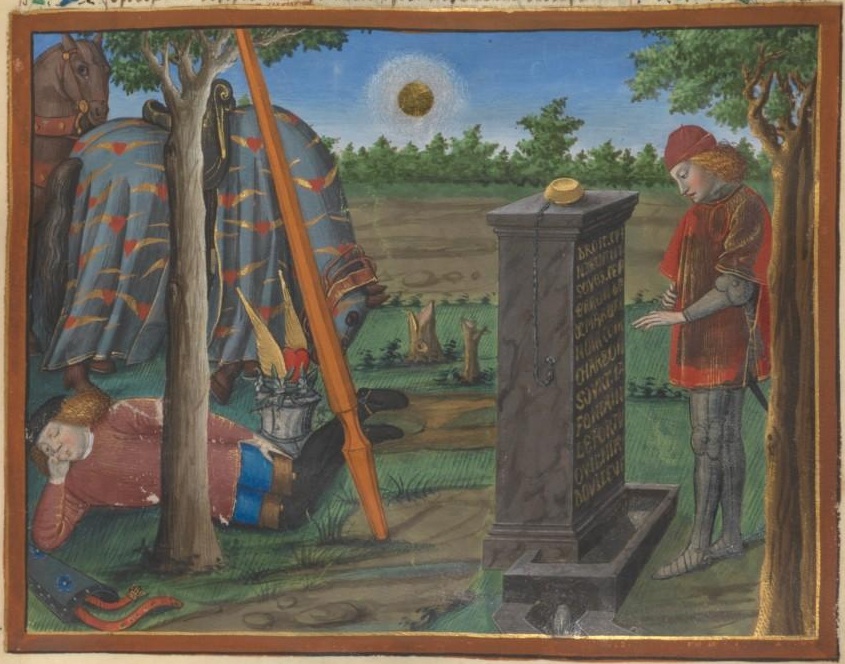
31_11 | Il cavalier Coeur legge l'iscrizione sulla fontana della Fortuna, miniatura da Barthélemy d'Eyck detto Maestro di René (attribuito), Le Livre du Coeur d'Amours Espris di Renato d'Angiò, manoscritto, 1457 ca., Vienna, Österreichische Nationalbibliothek, Cod. Vindob. 2597, fol. 12v.
31_11 | Chevalier Coeur reads the inscription on the fountain of Fortune, illumination from Barthélemy d’Eyck named Maestro di René (attributed), Le Livre du Coeur d'Amours Espris di Renato d'Angiò, manuscript, 1457 ca., Wien, Österreichische Nationalbibliothek, Cod. Vindob. 2597, fol. 12v.
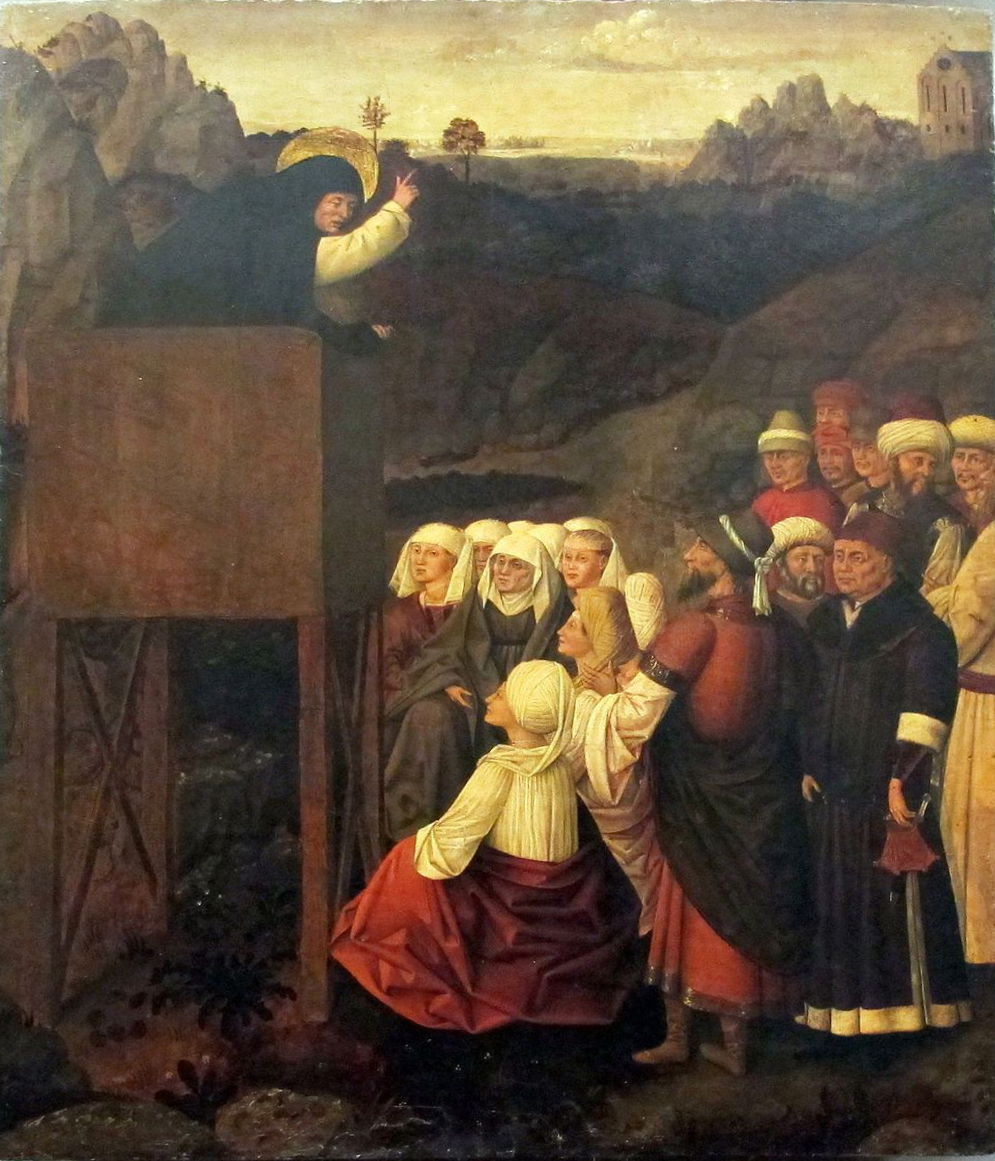
31_12 | Colantonio, Scena dalla vita di S. Vincenzo Ferrer, pannello da un polittico, Napoli, San Pietro Martire, Napoli, Museo di Capodimonte.
31_12 | Colantonio, Scene from the life of St. Vincent Ferrer, panel from a polyptych, Napoli, San Pietro Martire, Napoli, Museo di Capodimonte.
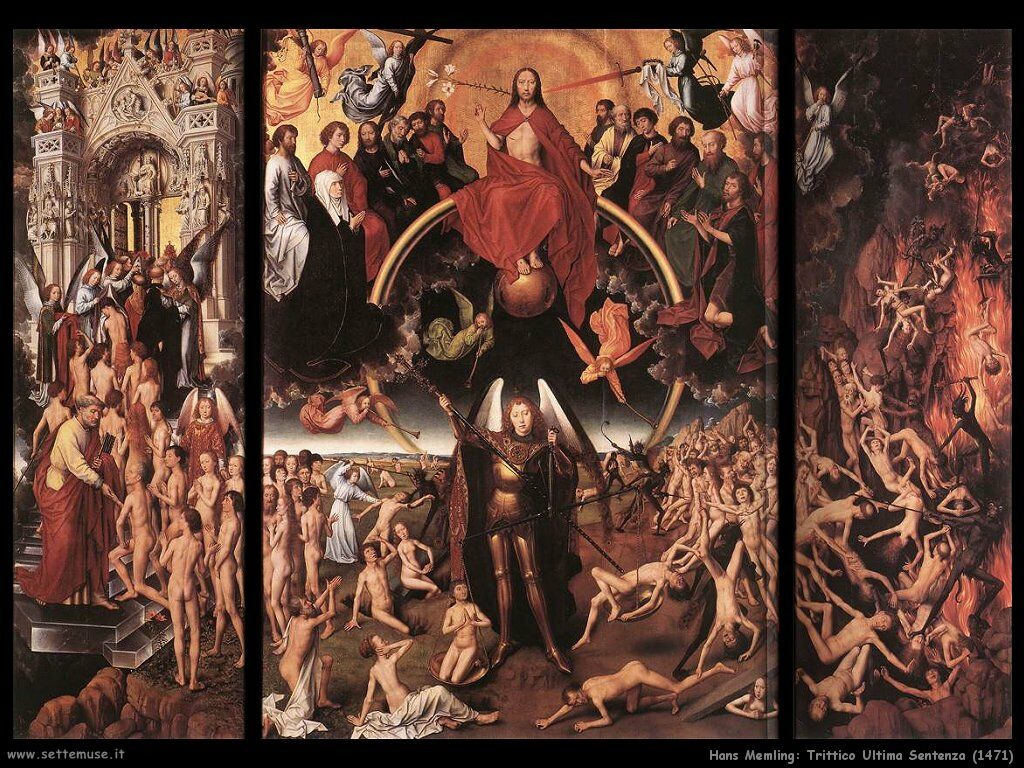
31_13 | Hans Memling, Trittico del giudizio universale, olio su tavola, 1466-1473, Danzig, Muzeum Pomorskie, già Marienkirche.
31_13 | Hans Memling, The Last Judgment, triptych, oil on table, 1466-1473, Danzig, Muzeum Pomorskie, formerly Marienkirche.
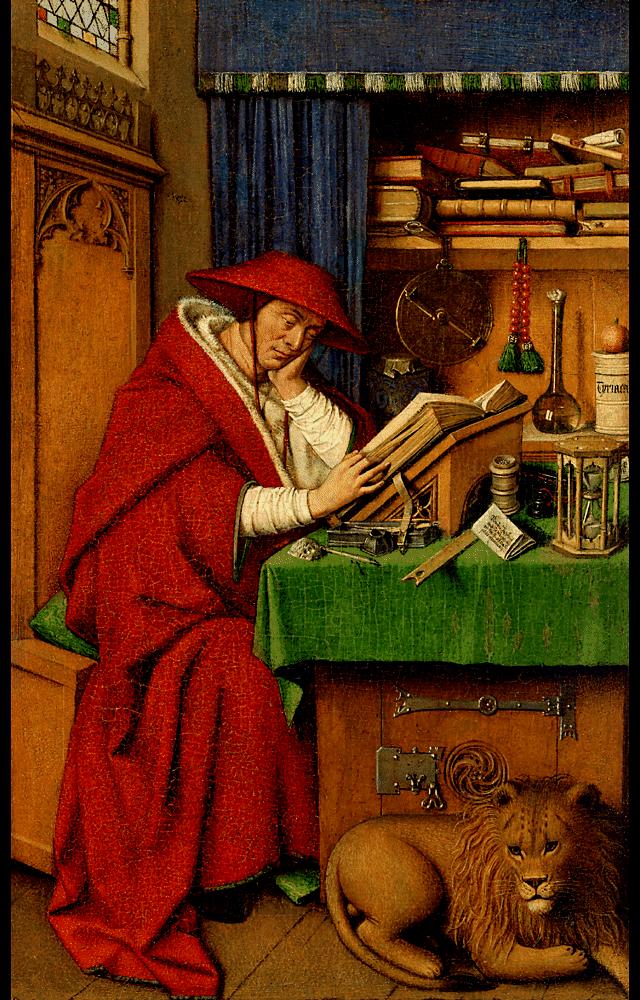
31_14 | Jan van Eyck?, San Girolamo nello studio, tempera e olio su tavola, Detroit, Institute of Fine Arts.
31_14 | Jan van Eyck, Saint Jerome in His Study, tempera and oil on table, Detroit, Institute of Fine Arts.
